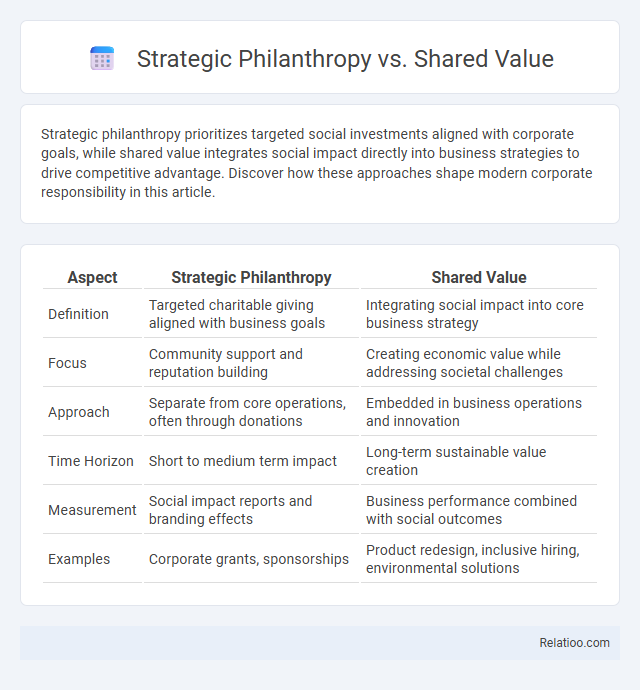Strategic philanthropy prioritizes targeted social investments aligned with corporate goals, while shared value integrates social impact directly into business strategies to drive competitive advantage. Discover how these approaches shape modern corporate responsibility in this article.
Table of Comparison
| Aspect | Strategic Philanthropy | Shared Value |
|---|---|---|
| Definition | Targeted charitable giving aligned with business goals | Integrating social impact into core business strategy |
| Focus | Community support and reputation building | Creating economic value while addressing societal challenges |
| Approach | Separate from core operations, often through donations | Embedded in business operations and innovation |
| Time Horizon | Short to medium term impact | Long-term sustainable value creation |
| Measurement | Social impact reports and branding effects | Business performance combined with social outcomes |
| Examples | Corporate grants, sponsorships | Product redesign, inclusive hiring, environmental solutions |
Introduction to Strategic Philanthropy and Shared Value
Strategic philanthropy aligns your charitable efforts with core business objectives to create measurable social impact while enhancing long-term competitiveness. Shared value focuses on identifying business opportunities that simultaneously address societal challenges, driving economic and social progress. Both approaches integrate social goals into business strategies but differ in how value is created and measured.
Defining Strategic Philanthropy
Strategic philanthropy aligns charitable efforts with core business objectives to create measurable social impact while advancing the company's long-term goals. Unlike shared value, which integrates social progress directly into profitable business strategies, strategic philanthropy focuses on targeted giving that leverages corporate strengths for community benefit. Your organization can enhance social responsibility by defining clear objectives, measuring outcomes, and embedding philanthropy within its overall strategic framework.
Understanding Shared Value
Understanding Shared Value involves creating economic value in a way that also creates value for society by addressing its needs and challenges. Unlike Strategic Philanthropy, which focuses on using corporate resources for social causes often separated from core business, Shared Value integrates social progress directly into the competitive strategy of the company. This approach drives innovation and growth by aligning business success with societal improvement, making it a sustainable model for long-term impact.
Key Differences Between Strategic Philanthropy and Shared Value
Strategic philanthropy focuses on using charitable donations to advance a company's social goals while enhancing its brand reputation, often through targeted giving or community investments. Shared value emphasizes integrating social impact directly into core business strategies to drive economic value and societal benefits simultaneously. Your choice between strategic philanthropy and shared value depends on whether you prioritize standalone social contributions or embedding social purpose within your business model for sustainable growth.
Business Motivations for Each Approach
Strategic philanthropy centers on aligning charitable efforts with a company's core business objectives to enhance brand reputation and stakeholder relationships while achieving social impact. Shared value emphasizes creating economic value in a way that also produces value for society by addressing social needs through innovation and business strategy. Shared value initiatives drive competitive advantage by integrating social progress into profit-making activities, fostering long-term sustainable growth and market differentiation.
Impact Measurement and Evaluation
Strategic philanthropy prioritizes impact measurement by setting clear goals and using quantitative metrics to assess social outcomes, ensuring Your initiatives align with business objectives and deliver measurable benefits. Shared value focuses on creating economic value in tandem with social progress, employing both qualitative and quantitative evaluation methods to gauge long-term systemic impact on communities and markets. In contrast, Shared Responsibility emphasizes collaborative impact measurement among stakeholders, highlighting transparency and continuous improvement through participatory evaluation frameworks.
Case Studies: Strategic Philanthropy in Action
Strategic philanthropy integrates corporate resources to achieve social impact aligned with business goals, exemplified by Pfizer's Global Health Programs targeting diseases in developing countries. Shared value initiatives, like Nestle's Coffee Plan, create economic value by addressing societal challenges, boosting farmer incomes while ensuring sustainable supply chains. Case studies reveal strategic philanthropy's emphasis on targeted grants and partnerships that generate measurable social returns alongside corporate benefits.
Case Studies: Shared Value Initiatives
Case studies of Shared Value initiatives highlight companies like Nestle, which created shared economic and social value through its rural development programs, improving farmer incomes and securing supply chains. Unilever's Sustainable Living Plan demonstrates how integrating social goals into business operations drives innovation and market growth while addressing environmental challenges. These examples reveal how Shared Value strategies align corporate profitability with societal impact, differentiating from traditional Strategic Philanthropy by embedding social progress into core business models.
Challenges and Criticisms
Strategic philanthropy often faces criticism for prioritizing corporate interests over genuine social impact, leading to skepticism about its authenticity and long-term benefits. Shared value initiatives struggle with balancing profit motives and social goals, as companies may face challenges in measuring true societal impact and avoiding superficial efforts labeled as "greenwashing." Your engagement in these approaches requires careful scrutiny of potential conflicts between corporate objectives and community needs to ensure meaningful and sustainable outcomes.
Future Trends in Corporate Social Impact
Strategic philanthropy evolves to integrate measurable social impact with business objectives, driving long-term value creation beyond traditional charitable giving. Shared value emphasizes aligning corporate success with societal progress by innovating products and operations that meet social needs while fostering economic growth. Future trends in corporate social impact highlight converging models where Your organization's commitment to environmental, social, and governance (ESG) metrics and stakeholder collaboration reshapes industry standards toward sustainable development and inclusive growth.

Infographic: Strategic Philanthropy vs Shared Value
 relatioo.com
relatioo.com